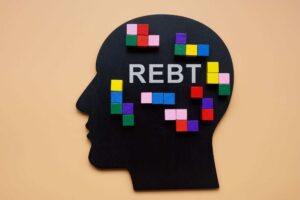In the shadowy labyrinth of addiction, rationality often seems like a distant beacon. Yet, within the chaos, there exists a therapeutic approach that illuminates a path toward recovery. Rational Emotive Behavior Therapy (REBT) stands as a stalwart guide, offering a structured framework to navigate the tumultuous waters of addiction. In this blog, we delve into REBT for addiction, exploring how its principles can empower individuals to break free from the chains of substance dependence.
Contents
What Is Rational Emotive Behavioral Therapy For Substance Abuse?
 REBT for substance abuse is a therapeutic approach rooted in the understanding that irrational beliefs and distorted thinking patterns contribute significantly to addictive behaviors. Developed by psychologist Albert Ellis in the 1950s, REBT posits that it is not solely the presence of substances that drives addiction, but rather the individual’s interpretations and reactions to life events, stressors, and emotions.
REBT for substance abuse is a therapeutic approach rooted in the understanding that irrational beliefs and distorted thinking patterns contribute significantly to addictive behaviors. Developed by psychologist Albert Ellis in the 1950s, REBT posits that it is not solely the presence of substances that drives addiction, but rather the individual’s interpretations and reactions to life events, stressors, and emotions.
In the context of substance abuse, REBT aims to identify and challenge irrational beliefs surrounding the use of drugs or alcohol. Ultimately fostering healthier coping mechanisms and lifestyle choices.
Central to REBT for substance abuse is the ABC model, which explores the interplay between Activating Events, Beliefs, and Consequences. REBT equips individuals with practical skills such as mindfulness, problem-solving, and assertiveness training to navigate triggers and challenges in their journey toward recovery from substance abuse.
What Are The 3 Basic Musts For REBT For Addiction?
In Rational Emotive Behavior Therapy (REBT) for addiction, there are three fundamental “musts” that individuals are encouraged to recognize and challenge:
1. “I must always be able to cope with life’s challenges and frustrations perfectly.”
2. “Others must always treat me fairly, kindly, and acceptably, or else they are terrible people who deserve blame and condemnation.”
3. “Life must always give me what I want, when I want it, or else it’s intolerable and catastrophic.”
These three “musts” represent irrational beliefs that often underlie addictive behaviors. By identifying and disputing these beliefs, individuals can gain insight into their thought patterns and begin to replace them with more rational and adaptive beliefs, ultimately facilitating recovery from addiction.
How Does REBT For Addiction Work?
 REBT for addiction works by addressing the underlying irrational beliefs and distorted thinking patterns that contribute to addictive behaviors. The therapy process typically involves several key steps:
REBT for addiction works by addressing the underlying irrational beliefs and distorted thinking patterns that contribute to addictive behaviors. The therapy process typically involves several key steps:
- Identifying Irrational Beliefs
Clients work with their therapist to identify irrational beliefs related to their addiction. These beliefs often revolve around themes such as perfectionism, entitlement, and self-worth.
- Challenging Irrational Beliefs
Once identified, clients learn to challenge and dispute their irrational beliefs. This involves examining the evidence for and against these beliefs and adopting more rational perspectives.
- Restructuring Thought Patterns
Through cognitive restructuring techniques, individuals learn to replace irrational beliefs with more rational and constructive thoughts. This helps them develop healthier coping mechanisms and responses to triggers for substance use.
- Developing Coping Skills
REBT equips clients with practical coping skills to manage cravings, stress, and negative emotions without resorting to substance use. These may include mindfulness techniques, relaxation exercises, and assertiveness training.
- Behavioral Experiments
Clients engage in behavioral experiments to test the validity of their irrational beliefs. And observe the consequences of adopting more rational beliefs and behaviors.
- Relapse Prevention
REBT for addiction emphasizes relapse prevention strategies, helping clients identify high-risk situations, develop coping plans, and build resilience to prevent relapse and maintain long-term sobriety.
Overall, REBT for addiction provides individuals with a structured framework for understanding and addressing the cognitive and emotional factors underlying their addictive behaviors, empowering them to make positive changes and achieve lasting recovery.
What Are The Main Techniques In REBT?
 Rational Emotive Behavior Therapy (REBT) employs several main techniques to help individuals identify, challenge, and change their irrational beliefs and maladaptive thought patterns.
Rational Emotive Behavior Therapy (REBT) employs several main techniques to help individuals identify, challenge, and change their irrational beliefs and maladaptive thought patterns.
Best Techniques
Some of the primary techniques used in REBT include:
ABC Model
The ABC model is a cornerstone of REBT. It stands for Activating Event, Beliefs, and Consequences. Clients learn to identify the activating events or triggers, examine the irrational beliefs they hold in response to these events, and recognize the emotional and behavioral consequences that result from these beliefs.
Disputing Irrational Beliefs
Once irrational beliefs are identified, clients are taught to dispute and challenge them using logical reasoning and evidence-based arguments. This involves questioning the accuracy, validity, and usefulness of irrational beliefs and replacing them with more rational alternatives.
Cognitive Restructuring
Cognitive restructuring techniques help individuals replace irrational thoughts with more rational and constructive ones. This process involves identifying cognitive distortions, reframing negative or catastrophic thinking, and developing more adaptive interpretations of events.
Homework Assignments
Clients are often assigned homework exercises to practice applying REBT techniques in their daily lives. These may include keeping thought records, challenging irrational beliefs, or engaging in behavioral experiments to test new beliefs and behaviors.
Behavioral Activation
REBT incorporates behavioral techniques to encourage individuals to engage in activities that promote emotional well-being and support their goals. This may involve scheduling enjoyable or meaningful activities, practicing assertiveness, or facing feared situations gradually.
Mindfulness and Acceptance
REBT may integrate mindfulness and acceptance-based practices to help individuals cultivate present-moment awareness, tolerate discomfort, and develop greater self-compassion. These techniques can complement cognitive restructuring efforts and enhance overall emotional resilience.
These techniques, combined with a collaborative therapeutic relationship between the client and therapist, form the foundation of REBT and facilitate positive changes in beliefs, emotions, and behaviors.
What Are The Benefits And Risks Of REBT For Addiction?
Rational Emotive Behavior Therapy (REBT) offers several benefits for individuals struggling with addiction:
Benefits
- Identifies Underlying Issues: REBT helps individuals identify and address the underlying irrational beliefs and distorted thinking patterns that contribute to addictive behaviors. By understanding the root causes of their addiction, clients can develop more effective coping strategies and make lasting changes.
- Enhances Coping Skills: REBT equips clients with practical coping skills to manage cravings, stress, and negative emotions without resorting to substance use. These skills include mindfulness techniques, problem-solving strategies, and assertiveness training. This empowers individuals to navigate triggers and challenges in recovery.
- Encourages Personal Responsibility: This emphasizes personal responsibility and accountability for one’s thoughts, feelings, and behaviors. By accepting responsibility for their choices and actions, clients can regain a sense of agency and control over their lives, empowering them to pursue positive change.
- Fosters Emotional Resilience: Finally, it helps individuals develop emotional resilience and flexibility, enabling them to tolerate discomfort, cope with setbacks, and adapt to life’s challenges without turning to substances. This increased resilience promotes long-term sobriety and overall well-being.
Risks
However, there are also some potential risks or limitations to consider with REBT for addiction:
- Requires Active Participation: REBT requires active participation and engagement from clients, as they are tasked with challenging and changing deeply ingrained beliefs and behaviors. Clients who are resistant to therapy or unwilling to confront their issues may not experience the full benefits of REBT.
- May Not Be Effective for Everyone: While REBT can be highly effective for many individuals, it may not be suitable for everyone or every type of addiction. Clients with severe mental health issues or complex trauma histories may require additional support or alternative therapeutic approaches.
- Risk of Emotional Discomfort: Engaging in cognitive restructuring and confronting irrational beliefs can be emotionally challenging and may temporarily increase feelings of discomfort or distress. Therapists need to provide adequate support and guidance to help clients navigate these difficult emotions safely.
- Relapse Risk: Despite its effectiveness, REBT does not guarantee complete avoidance of relapse. Addiction is a complex and multifaceted issue, and relapse may occur as part of the recovery process. Clients need ongoing support and reinforcement of coping skills to minimize the risk of relapse.
Overall, the benefits of REBT for addiction often outweigh the risks, particularly when delivered by qualified and experienced therapists within a comprehensive treatment program.
Conclusion
In conclusion, REBT for addiction offers a promising path to overcome by addressing the root causes of substance abuse through cognitive restructuring, coping skill development, and personal responsibility. By challenging irrational beliefs and replacing them with more rational and constructive thoughts, individuals can gain control over their behaviors and emotions. Ultimately leading to long-term sobriety and improved well-being.
With dedication, support, and the guidance of qualified therapists, individuals can harness the power of REBT to break free from addiction. Hence, embrace a life of health, fulfillment, and self-determination.
